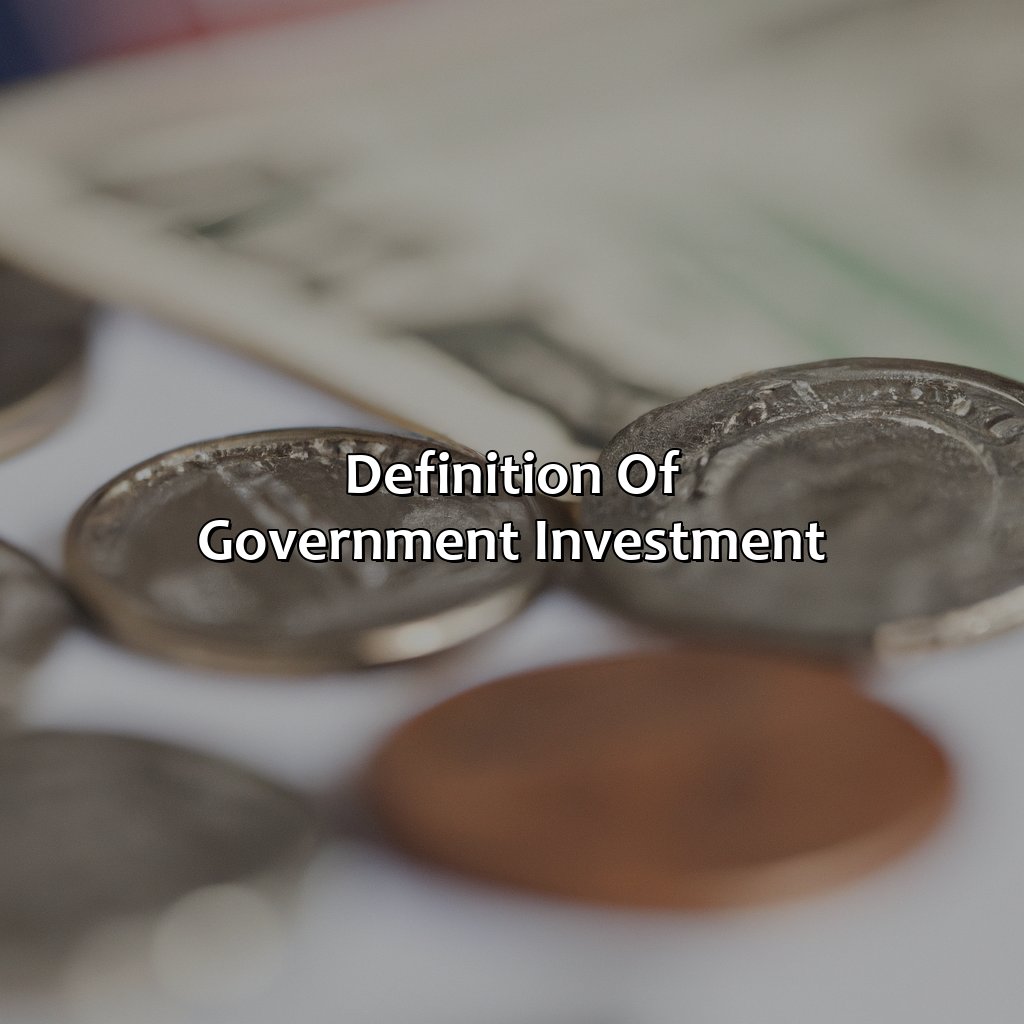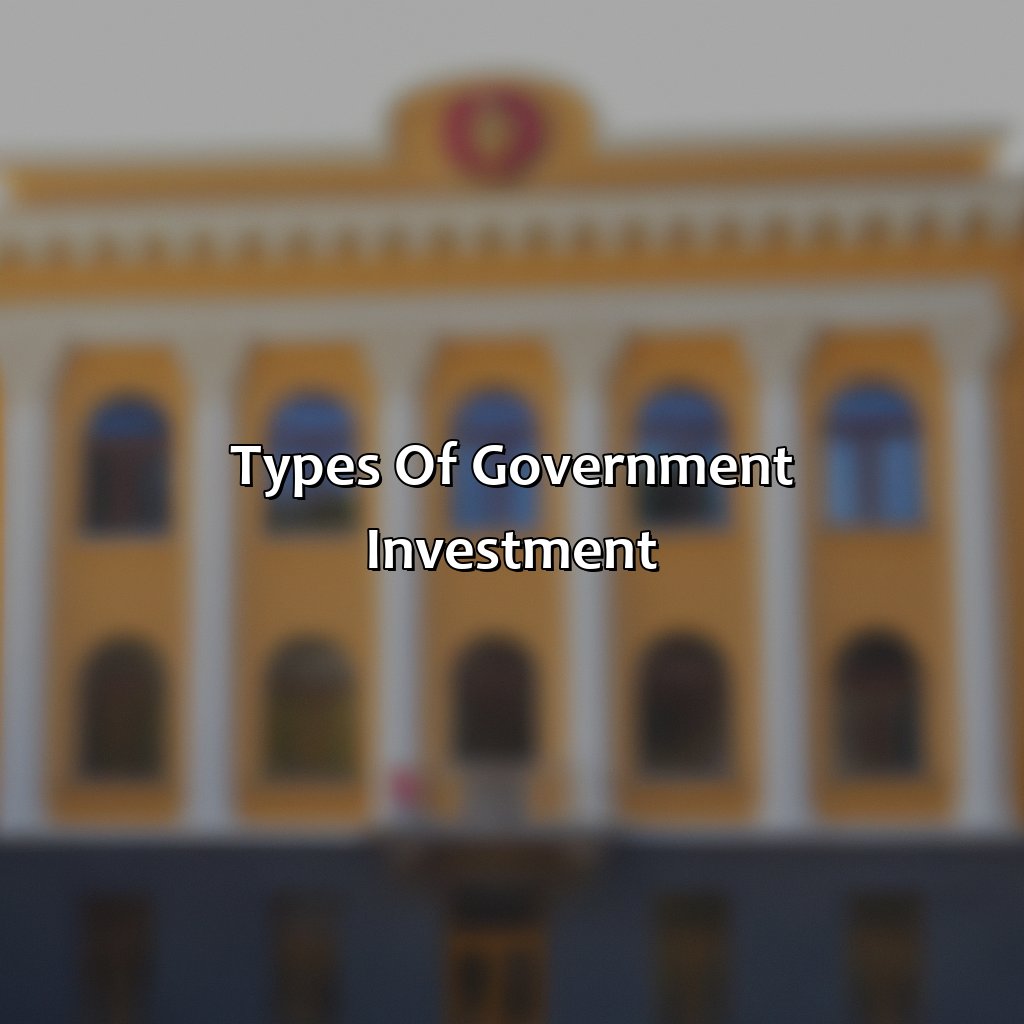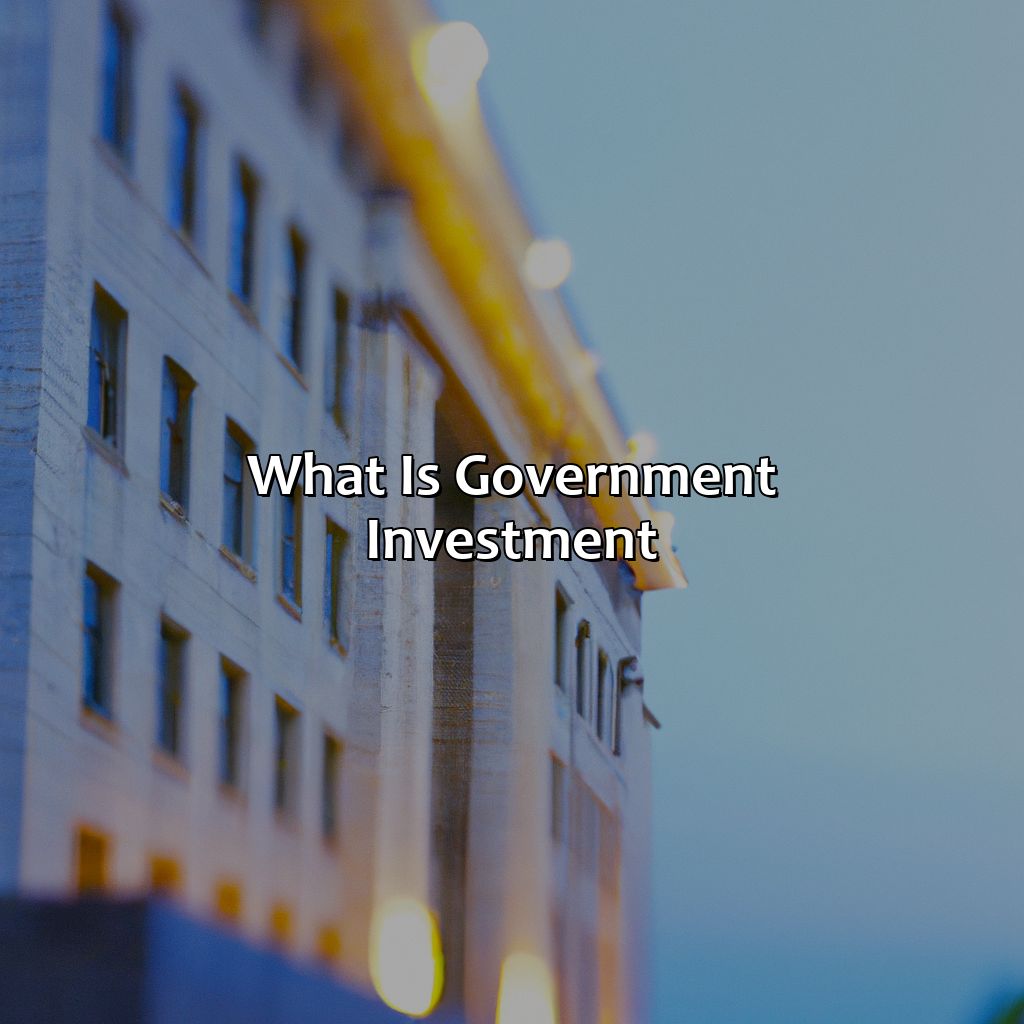What Is Government Investment?
Key Takeaway:
- Government investment refers to the money that is spent by government to promote economic, social, and environmental goals.
- Government investment can take different forms, including infrastructure investment, education and training investment, research and development investment, and healthcare investment, each with its own benefits and impacts.
- Government investment is important because it helps to stimulate economic growth, create jobs, and improve social welfare. By investing in key sectors and areas, governments can build a more prosperous and sustainable future for their citizens.
- Examples of government investment include public transportation infrastructure, grants for education and training programs, research and development funding for science and technology, and healthcare facilities and programs.
Do you want to know how the government invests in its citizens and the economy? As a taxpayer, it’s important to understand where your money goes. This article will discuss what government investment is and the impact it has.
Definition of Government Investment
Government Investment: Understanding the Concept
Government investment refers to the allocation of resources by the government towards public goods and services. It is a crucial fiscal policy tool used to ensure a stable economy by influencing aggregate demand and supply.
Governments utilize different types of investments including infrastructure, education, healthcare and social security to create sustainable growth and development. These investments provide a secure environment that encourages businesses to invest in a country, leading to economic growth.
It is important to note that government investments are not always financially profitable but they aim to create long term economic growth which leads to a healthy and stable economy.
Historically, government investments have been used to address social issues such as poverty, inequality, education, healthcare and infrastructure. The New Deal policies of the 1930s in the United States, implemented by President Franklin D. Roosevelt, can be seen as a prime example of government investment intended to boost economic growth and reduce unemployment during the Great Depression.

Image credits: retiregenz.com by David Washington
Types of Government Investment
Curious about the various kinds of government investment? Explore this “Types of Government Investment” section! Learn how investments in infrastructure, education and training, research & development, and healthcare can help a country grow and develop.

Image credits: retiregenz.com by Harry Jones
Infrastructure Investment
Investment in the development and maintenance of physical structures such as roads, bridges, water supply systems, communication lines, and other essential facilities falls under Public Works Investment. These infrastructures provide a foundation for various activities to prosper in a society and enable economic growth through transportation, efficient logistics and communication systems. Typically funded by governments, it aims to improve public services, support business, tackle poverty and attain social equity at scale.
In today’s world, infrastructure investment is regarded as one of the most substantial investments that can bring growth, development and prosperity across regions. Projects under public works investment are generally capital-intensive – creating employment opportunities for millions globally. However, it can also be risky due to ever-changing environmental factors and ineffective management of resources or not involving public consultation during planning stages.
Pro tip: Effective utilization of technology can enhance public participation in decision-making processes.
“Education is the investment that pays the highest interest, but I heard the government prefers to put their money in a low-yield savings account.”
Education and Training Investment
Investment in enhancing the knowledge and skills of individuals is paramount for any nation’s progress. The government has focused on Human Capital Investment, which includes Education and Training. This comprehensive approach is instrumental in building a competent workforce and nurturing future leaders.
The Government has been investing in various institutions for education and training to achieve excellence. It can be categorized into tertiary, secondary, and primary education investment. Tertiary education enables learners to acquire advanced skills through universities, vocational colleges, and polytechnics tailored to meet the industry needs. Secondary education caters to students between 13-18 years of age, where they receive broader subjects for expanding their abilities. Primary investment focuses on basic literacy and numeracy skills, which are fundamental stepping stones towards a prosperous future.
The Government’s commitment extends beyond funding as it works with other stakeholders like non-governmental organizations (NGOs), industries, educational establishments, local councils, families, schools, among others to provide quality education services effectively.
In ancient Greece and Rome, formal education occurred in houses amongst privileged males. During the renaissance era in Europe, discipline-based schooling emerged. In contrast to our modern-day educational system of mixing core subjects with electives stemmed from Northern Germany that developed unparalleled methods of educational systems that improved individualism under a single name: Gymnasiums or Latin Schools – a kind of preparatory school for university entrance.
If the government’s research and development investments were a Tinder profile, they’d be the one everyone swipes right on for the long-term potential.
Research and Development Investment
Investments made by the government in research and development aim to support innovation and scientific advancements. Such investments involve funding for projects that contribute to the creation of new products, technologies, and processes. This type of investment is crucial for long-term growth and competitiveness in various sectors, including health, defense, energy, and telecommunications.
Research and development investments go beyond providing financial support for specific projects. They also entail collaborations with academic institutions, research organizations, and private companies to create an ecosystem that fosters innovation. The government encourages knowledge-sharing between different stakeholders so that ideas get executed swiftly.
These investments imply significant risks as they often require a considerable amount of time before tangible results can be seen. Still, they have higher payoff potentials compared to other types of investments since breakthroughs could lead to substantial economic rewards in the future.
Pro Tip: Being aware of available research opportunities and understanding how to apply for grants is instrumental in securing funds for innovative projects.
Who needs a doctor when you have the government investing in healthcare – it’s like having a hypochondriac sugar daddy!
Healthcare Investment
Investment in the Health Sector
Investment in the health sector is a crucial aspect of government investment. It involves funding and allocating resources to healthcare institutions, research facilities, and projects aimed at improving public health.
The impact of government investment in healthcare can be seen from improvements in infrastructure, expansion of medical coverage, research and development of new therapies, and increased access to medications for treatment and prevention.
The government also invests in programs that address social determinants of health such as education, housing, sanitation, and nutrition, which are essential for promoting healthy behavior.
Understandably, proper investment in the health sector leads to healthier communities, reduced healthcare costs through early detections and treatments of diseases. This creates a significant positive impact on society at large.
It’s crucial for policymakers to prioritize investment in healthcare due to its significant role in overall economic growth while providing substantial benefits to citizens’ social welfare.
Without government investment, the economy would be as stable as a Jenga tower built by a drunk toddler.
Importance of Government Investment
Grasp the value of government investment and the effects on economic growth, job openings, and social welfare. To investigate these topics further, look into their benefits. Government investment can offer a range of advantages to the economy, for example, job chances and better social welfare. Investing in infrastructure, education, and healthcare can increase the economy’s growth. This leads to increased wealth and wellbeing for society.

Image credits: retiregenz.com by Yuval Duncun
Economic Growth
Maximizing National Monetary Expansion
Economic growth can be catalyzed by government investment, which refers to the allocation of resources and funds for activities aimed at boosting economic development. Efficient investment is critical in providing the necessary stimulus for increasing output, creating more employment opportunities, and promoting private sector growth. When governments invest in relevant sectors such as infrastructure, healthcare, and education, it triggers a multiplier effect that stimulates all industries. Annually appropriating a portion of national income for government investments can guarantee long-term macroeconomic stability.
By directing investments towards essential sectors like transport and energy, governments stimulate economic growth that fosters job creation both directly and indirectly. This strategy enhances a country’s competitiveness, promotes sustainable development goals and improves living standards for citizens. With these policies in place, businesses are more likely to grow and create diverse markets fit to pursue value addition projects while offering communities safe job opportunities.
To further accelerate the progress achieved by government investments towards economic growth strategies such as public-private partnerships may come in handy. Through pooling of resources from both parties, larger infrastructural projects can be carried out with minimal resource constraints while providing substantial spillover benefits nationally.
Pro Tip: Investing funding into critical sectors of an economy guarantees long-term macroeconomic stability; this assures increased productivity and overall economic prosperity projected at improving the quality of life globally.
Governments love creating jobs, it’s like they’re trying to make a game out of unemployment.
Job Creation
Investing in Government Initiatives Paves the Way for New Employment Opportunities
Public investment in infrastructure, education, healthcare and skill training programs can boost job creation. These projects can create a direct demand for labour, as well as attract investments from private players, which in turn leads to enhanced economic development and employment opportunities for individuals. The spillover effect can be significant, where more people are employed across various sectors from manufacturing and construction to services and hospitality.
Governments should focus on creating an environment that encourages investors and entrepreneurs to launch new ventures that help create job opportunities. This can happen through incentives like tax breaks, subsidies and regulations designed to encourage innovation-driven startups that will generate high-quality jobs with better wages and benefits than traditional jobs.
Investment without action is merely academic; therefore, governments worldwide must invest in policies that support business growth which in turn leads to higher job generation. Adequate provision of funding may lead to faster realization of these goals by ensuring adequate skill acquisition through flexible online learning platforms. Saving up is tempting but investing money could make all the difference between financial struggles or independence.
Social welfare: Because nothing says ‘I care about people’ like a government program that still has a waiting list.
Social Welfare
Investing in societal welfare is a crucial factor for any prudent government. Providing assistance to vulnerable groups, creating access to affordable healthcare, and securing basic human rights falls under this ambit. Such investments lead to social cohesion, increased productivity, and ultimately contribute towards the development of the economy.
A welfare state must cater to its people’s needs by enabling them access to education and employment opportunities, hence guaranteeing a good quality of life. Ensuring minimal income through subsidies, pension schemes and allowances make it feasible for marginalized sections of society to improve their lives.
Moreover, investment in social welfare also constitutes support provided to families facing hardships such as illness or unemployment. This further boosts people’s standard of living while serving as a safety net for the community as a whole.
Pro Tip: Investment in social welfare should be more focused on promoting self-sustainability rather than providing mere financial aid for survival purposes. Why just bail out corporations when you can invest in projects that actually benefit the people? Government investment is like choosing the salad over the deep-fried appetizers.
Examples of Government Investment
Gain insights into four main government investments. Learn how:
- Public transport infrastructure
- Grants for education/training
- Research/development funding for science/tech
- Healthcare facilities/programs
create a positive effect. Explore these examples of government investment!

Image credits: retiregenz.com by Joel Woodhock
Public Transportation Infrastructure
The government invests in the development of transportation networks, including roads, bridges, and public transit systems. Upgrades to existing transportation infrastructure, such as the implementation of high-speed trains or new subway lines, are also a priority. This investment improves accessibility and mobility for citizens, reduces congestion, and lowers pollution levels.
With this investment in public transportation infrastructure comes job creation opportunities and increased economic growth potential. Additionally, it can lead to enhanced access to education and healthcare facilities for citizens who would otherwise struggle with long commutes.
Notably, a recent study by the American Public Transportation Association found that for every $1 billion invested in public transportation projects, up to 50,000 jobs are created.
(Source: https://www.apta.com/wp-content/uploads/Resources/resources/reportsandpublications/Documents/APTA_InfoGraphic_Report.pdf)
Looks like the government finally realized investing in education is the key to avoiding another generation of influencers and TikTok stars.
Grants for Education and Training Programs
Government Funding for Learning and Development Programs
Government investment in education and training is crucial for nurturing a knowledgeable, skilled, and productive workforce. It provides grants and funding to various organizations that offer learning and development programs aimed at enhancing the skills of job seekers, employees, and employers.
Some examples of grants provided by the government for education and training programs include:
- Apprenticeships: Grants are available to train apprentices in key areas where companies face skill shortages.
- Adult Education: Grants are provided for adult learners to build their skills or transition into new careers.
- Workplace Training: Companies can access government-funded support to provide training opportunities to their staff members.
It is noteworthy that these funds have specific eligibility criteria, such as industry sectors or geographic regions with high unemployment rates. Additionally, organizations receiving these grants must report on the training outcomes when applying in subsequent years.
To maximize the benefits of government investments in education and training programs, organizations should develop effective strategies such as assessing skill gaps, selecting suitable trainers or providers, offering flexible modes of delivery, monitoring feedback from participants, and aligning the program goals with organizational objectives.
Science may never discover the cure for aging, but with government funding for research and development, at least we’ll have better anti-wrinkle creams.
Research and Development Funding for Science and Technology
Supporting scientific and technological advancements through financial investment is a significant government strategy. Funding for research and development (R&D) in science and technology leads to innovations that improve lives. The government invests directly by providing R&D grants, contracts, and awards to individuals, academic institutions, businesses, and organizations.
Government investment in R&D has led to some incredible breakthroughs, such as the creation of the internet, air conditioning units, radar technology, and medicine. Investment in science and technology has also enabled critical advancements in renewable energy sources such as wind turbines and solar panels. Government funding for science and technology programs also creates job opportunities for highly skilled professionals.
One unique example of government investment in R&D is the Advanced Research Projects Agency-Energy (ARPA-E). ARPA-E invests in high-risk/ high-reward projects that could lead to game-changing breakthroughs in energy technology. Established by the Department of Energy under President Obama’s administration, it supports research on everything from bioenergy to carbon capture technologies.
In 1961, President John F. Kennedy established the United States Agency for International Development (USAID). USAID provides economic support to developing countries worldwide via investments ranging from agriculture to healthcare initiatives. As of 2019 alone, USAID had a budget of $19 billion for aid programs across various sectors.
Healthcare Facilities and Programs
Government investment in the domain of medical concerns has been instrumental in ensuring affordable health care assistance to all community members. Medical facilities such as public hospitals, clinics, and rehabilitation centers are a result of government investment in the healthcare sector.
Additionally, vaccination programs, disease control measures, and research funding also come under government healthcare investment. With appropriate allocation of funds to this sector, governments aim to provide better medical assistance for its citizens while promoting healthy living.
Through strategic partnerships with private organizations and healthcare providers, governments can pool resources and build more comprehensive medical facilities that deliver quality care services. Moreover, offering tax incentives to businesses that invest in healthcare projects also serves as an effective way of encouraging further investment in the medical field.
In turn, this aids organizational growth while positively impacting the health outcomes of society. Effective government investments within healthcare facilities and programs have led to improved access to medical aid for people across diverse demographics.
Some Facts About Government Investment:
- ✅ Government investment refers to the funds that the government allocates for specific projects and initiatives to promote economic growth and development. (Source: Investopedia)
- ✅ Government investment can include spending on infrastructure, education, healthcare, research and development, and social welfare programs. (Source: The Balance)
- ✅ Government investment is often used as a tool to create jobs and stimulate economic activity. (Source: Forbes)
- ✅ Government investment can be financed through taxes, borrowing, or other sources of revenue. (Source: IMF)
- ✅ The effectiveness of government investment depends on factors such as the quality of projects, governance, and accountability. (Source: World Bank)
FAQs about What Is Government Investment?
What is government investment?
Government investment refers to the allocation of resources by a government towards projects and programs aimed at achieving the goals of economic growth and development.
What are the types of government investment?
The types of government investment include capital investment, human capital investment, research and development investment, infrastructure investment, and social investment.
How does government investment contribute to economic growth?
Government investment contributes to economic growth by stimulating aggregate demand, increasing productivity and competitiveness, improving infrastructure, and enhancing the quality of human capital through education and training programs.
What are the benefits of government investment?
The benefits of government investment include job creation, increased economic output, improved public services, enhanced social welfare, and strengthened national competitiveness.
What are the risks of government investment?
The risks of government investment include misallocation of resources, corruption, political interference, inefficiency, and lack of accountability and transparency.
What is the role of government investment in promoting sustainable development?
The role of government investment in promoting sustainable development is to invest in projects and programs that reduce poverty, promote social inclusion, protect the environment, and foster innovation and technological advancement.
